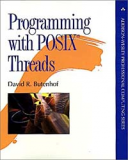Книга: Programming with POSIX® Threads
1.6.2 Concurrency
1.6.2 Concurrency
The threaded programming model allows the program to make computational progress while waiting for blocking operations like I/O. This is useful for network servers and clients, and it is the main reason that client/server systems (such as OSF DCE) use threads. While one thread waits for a long network read or write operation, that thread is blocked and other threads in your application can execute independently. Some systems support asynchronous I/O operations, which can give similar advantages; but most UNIX-based systems do not have asynchronous I/O.[2] Furthermore, asynchronous I/O is generally a lot more complicated to use than threads.
For example, you need to either handle asynchronous notification when the I/O completes, or poll for completion. If you issued an asynchronous I/O and then entered a polling loop, you would lose the advantage of asynchronous I/O— your application would just wait. If you poll elsewhere, or handle asynchronous notification, then issuing the I/O and processing the resulting data occur in different locations within your program. That makes the code more difficult to
analyze and maintain. When you use synchronous I/O you just perform the I/O and then do whatever comes next. Synchronous I/O within multiple threads gives nearly all the advantages of asynchronous I/O. In most cases you will find it much easier to write complex asynchronous code using threads than using traditional asychronous programming techniques.
You could write an alarm program, like those shown in Section 1.5, as an asynchronous program without using processes or threads, with timer signals for the alarms and asynchronous reads for input. Using timer signals is more complicated in many ways, since you are severely limited in what you can do within a signal handler. Asynchronous I/O does not allow you to take advantage of the convenience of stdio functions. The basic program function will be scattered through a series of signal handlers and functions, and will probably be harder to understand.
Asynchronous I/O does have one advantage over threaded concurrency, though. Just as a thread is usually "cheaper" (in execution time and storage space) than a process, the context required for an asynchronous I/O operation is almost always cheaper than a thread. If you plan to have a lot of asynchronous I/O operations active at the same time, that might be important enough to justify using the more complicated programming model. But watch out—some "asynchronous I/O" packages just distribute your I/O requests across a pool of threads! Most of the time you will be better off using threads.
Another method of coding an asynchronous application is for each action to be treated as an "event." Events are queued by some "hidden" process, and dispatched serially to be handled by the application, usually through "callback" routines registered with the dispatcher. Event dispatchers have been popularized by windowing interface systems such as the Apple Macintosh toolbox, Microsoft Windows, and X Windows on UNIX (used by Motif and CDE).
The event mechanism alleviates much of the complication of using signals and asynchronous I/O, as long as the events are supported directly by the event dispatcher. All, for example, handle input from the keyboard or pointer device, and generally one can request a timer event to be inserted automatically at a desired time. Thus, the alarm program, written to an event interface, need only initialize the event dispatcher and enter a loop to process events. Input events would be dispatched to the parser, resulting in a request for a new timer event; and timer events would be dispatched to a function that would format and print the alarm message.
For very simple applications (and the alarm program here is certainly one example), an event-based implementation may be simpler than the multiprocess or multithread variations I've shown — at least when the (often substantial) overhead of initializing the event dispatcher is removed. The limitations of events become more obvious when you build larger and more sophisticated applications—the problem is that the events are sequential.
Events are not concurrent, and the program can do only one thing at a time. Your application receives an event, processes it, and then receives the next event. If processing an event takes a long time, for example, sorting a large database,
the user interface may remain unresponsive for quite a while. If an event involves a long wait, for example, reading data over a slow network connection, then, again, the user must wait.
The response problems can be minimized by liberally sprinkling extended operations with calls to the event dispatcher—but getting them in the right place, without substantially impacting the performance of the operation, can be difficult. Furthermore, you may not have that option, if the database sort is taking place in a shared library you bought from somebody else.
On the other hand, one might code the application to create a new thread that runs the database sort, or reads from the slow network, leaving the "user interface" thread to immediately request another event. The application becomes responsive, while the slow operation continues to run. You can do this even if a database package, for example, cannot tolerate being run in multiple threads, by queuing a "sort" command to a server thread that runs database operations serially—while still retaining interface responsiveness.
- 3.4.4. Concurrency Control
- Chapter 14: Modularizing An Application For Concurrency
- 5.6 Synchronization, Communication, and Concurrency
- 10.3.2 Hardware Concurrency and Service Request Management
- 14.3 Guidelines and Recommendations for Identifying Concurrency
- 14.3.1 Units of Concurrency
- 1.2.2 Concurrency
- 1.2.6 Concurrency control functions
- 10.1.3 Set concurrency level
- Timestamp request
- 5.1 Introduction




